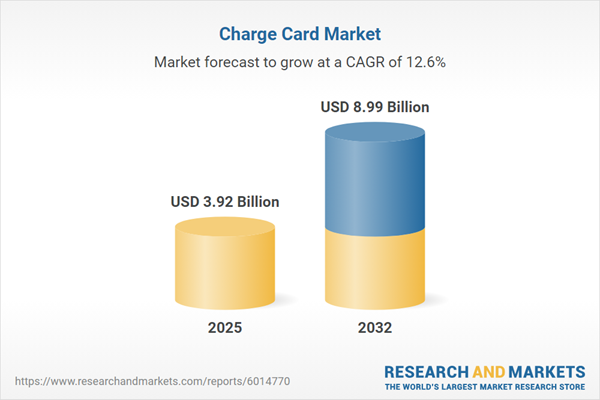Speak directly to the analyst to clarify any post sales queries you may have.
Charge card solutions are rapidly reshaping enterprise payments by offering organizations enhanced oversight, compliance, and process efficiency. As finance leaders drive digital transformation, the adoption of these tools supports greater control and resilience throughout corporate payment ecosystems.
Market Snapshot: Charge Card Market Size and Growth Outlook
The global charge card market reached USD 3.47 billion in 2024 and is projected to rise to USD 3.92 billion by 2025, reflecting a compound annual growth rate of 12.63%. Increased automation, the evolution of charge card features, and the expansion of digital expense management underpin this surge. As enterprises embed these solutions within payment infrastructures, streamlined onboarding and advanced capabilities support business agility. This steady momentum is expected to align with ongoing enterprise strategies and promote robust market evolution through 2032.
Scope & Segmentation of Charge Card Solutions
This report delivers actionable insights for senior decision-makers, analyzing essential segmentation factors and operational dynamics influencing the charge card market:
- Product Types: Co Branded Charge Cards facilitate alliances and enhance brand reach; Corporate Charge Cards ensure better expense management and procurement support; Premium and Standard cards offer scalable options for organizations; Virtual Charge Cards boost security for remote and decentralized teams.
- Card Usage Categories: Business Expenses cards increase transparency for audits; General Purchase cards streamline procurement payments; Travel and Entertainment cards address needs of globally mobile teams.
- Application Modes: In Branch Application supports structured onboarding processes with strong oversight; Online Application options simplify and accelerate digital sign-up for distributed teams.
- Regions & Sub-Regions: Coverage includes the Americas, Europe, the Middle East and Africa, and Asia-Pacific, each reflecting unique regulatory conditions and innovation trajectories that shape adoption patterns.
- Technological Innovations: Digital wallets enhance payment integration; AI spend analytics provide actionable oversight; Cloud-native platforms drive scalability and adaptability; Biometric authentication strengthens security, while embedded finance enables direct integration with core enterprise applications.
- Featured Companies: Comparative profiles of leading providers—including JPMorgan Chase & Co., Citigroup Inc., Bank of America Corporation, Capital One Financial Corporation, American Express Company, Discover Financial Services, U.S. Bancorp, Barclays Bank PLC, Synchrony Financial, and Wells Fargo & Company—showcase innovation and capabilities across the sector.
Key Takeaways and Strategic Insights
- Charge card programs build stronger financial oversight, supporting consistent policy enforcement and improved payment data security.
- Collaborations with fintech firms accelerate the implementation of advanced analytics and onboarding, broadening adoption across market sectors.
- Regional variances—such as mobile-first solutions in Asia-Pacific and fintech-driven innovation in Africa—are shaping how organizations approach card deployment and user interfaces.
- Instant issuance of virtual cards and real-time monitoring are aligning processes with evolving security, compliance, and audit standards.
- Adoption of cloud-native, API-based platforms allows organizations to adjust payment programs rapidly as business environments and technologies evolve.
- Seamless integration of expense management within charge card offerings is advancing digital transformation and simplifying financial reporting.
Tariff Impact and Industry Response
New tariffs anticipated in the United States for 2025 are expected to influence component costs associated with charge card systems. Organizations are proactively renegotiating supplier terms, prioritizing domestic sourcing, and evaluating fee structures to remain agile. A shift toward cloud-based platforms and software-centric solutions enables businesses to manage costs more effectively while minimizing reliance on physical infrastructure, supporting financial stability amid changing regulatory requirements.
Methodology & Data Sources
This research utilizes in-depth interviews with finance executives, structured user surveys, and ongoing regulatory analysis. Independent benchmarking and thorough evaluation ensure insights remain relevant and accurate for strategic planning.
Why This Report Matters
- Enables senior leaders to adapt charge card strategies to regulatory changes and emerging payment technologies, providing concise, actionable guidance for complex enterprise environments.
- Identifies growth opportunities, sectoral shifts, and regional trends to support informed decision-making and risk management for long-term value.
- Demonstrates how fintech integration, cloud adoption, and efficient onboarding support the scalability and performance of charge card programs within diverse organizational structures.
Conclusion
Charge card solutions are integral to enhancing automation, compliance, and operational agility in enterprise payments. Their adoption ensures organizations are equipped to adapt within dynamic payment ecosystems, supporting sustainable business performance.
Additional Product Information:
- Purchase of this report includes 1 year online access with quarterly updates.
- This report can be updated on request. Please contact our Customer Experience team using the Ask a Question widget on our website.
Table of Contents
3. Executive Summary
4. Market Overview
7. Cumulative Impact of Artificial Intelligence 2025
Companies Mentioned
The companies profiled in this Charge Card market report include:- JPMorgan Chase & Co.
- Citigroup Inc.
- Bank of America Corporation
- Capital One Financial Corporation
- American Express Company
- Discover Financial Services, Inc.
- U.S. Bancorp
- Barclays Bank PLC
- Synchrony Financial
- Wells Fargo & Company
Table Information
| Report Attribute | Details |
|---|---|
| No. of Pages | 193 |
| Published | October 2025 |
| Forecast Period | 2025 - 2032 |
| Estimated Market Value ( USD | $ 3.92 Billion |
| Forecasted Market Value ( USD | $ 8.99 Billion |
| Compound Annual Growth Rate | 12.6% |
| Regions Covered | Global |
| No. of Companies Mentioned | 11 |









